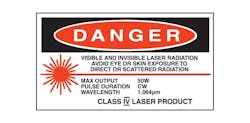Editor’s Note: When you’ve been working with a technology for five decades, you occasionally need reminders that others have not, and it’s a good idea to revisit some of the basics every once in a while—especially when it comes to laser safety. This article, courtesy of Mark Boyle, is about as fundamental as it gets.—David A. Belforte
I have written before about laser safety, but two topics come up repeatedly.
- What are the differences between Class 1 and Class 4 laser systems and what are the safety requirements for each?
- Which laser safety glasses should I use?
First, all industrial lasers are classified as Class 4, and can burn the skin and/or cause eye damage. Keep this in mind that when buying components such as a laser, the responsibility of ensuring laser safety according to ANSI Z136.1—including filing the necessary Center for Devices and Radiological Health (CDRH) reports—falls solely on the end user.
Laser systems, on the other hand, are classed into 2 categories: Class I and Class IV.
Differences between Class 1 and Class 4 laser systems
“Class 1” refers to a workstation that can be placed and operated anywhere in a factory; it is safe under all conditions of normal use. These workstations have been designed to be light-tight (except for CO2 lasers), and any viewing windows have correctly specified material for the laser wavelength and power density in accordance with the ANSI standard.
For CO2 lasers, a Class 1 system can be physically open, as long as there is a clearly defined hazardous “Keep Out” zone in accordance with the maximum possible exposure (MPE) or safe optical power density for that laser source. Fiber and disk lasers operating at 1 µm must be housed in closed light-tight enclosures for Class 1.
For Class 1 systems, all the necessary safety requirements are taken care of by the system integrator. This includes conforming interlocking, dual-channel emergency stop relay, and testing the light-tight enclosure. The CDRH report is also filed by the system integrator.
“Class 4” systems are open, with no protective barriers to stop the laser. These systems must be housed in a separate room or enclosed area with all of the appropriate warning lights, entry procedures, and protective safety glasses. All operators within the room or area where the Class 4 laser workstation resides must wear safety glasses.
Note that a Class 4 system does not require a CDRH report, but the end user must ensure safe Class 4 operation.
Selecting the right safety glasses
There are many styles and colors of laser safety glasses to choose from, but when it comes to picking out the right laser safety glasses, be careful to always match the wavelength marked on the glasses with the wavelength specified on the laser. Laser glasses also offer different levels of optical density (OD) for viewing protection. The higher the OD number, the less light will pass through to your eyes. I recommend using a minimum optical density of 6 at the lasing wavelength. The OD thresholds are typically marked on the glasses.
There’s a lot more to the issue of laser safety, so be sure to delve further in the Laser Institute of America’s resources, especially their Laser Safety Information Bulletin.
Mark Boyle, Ph.D. | Product Manager, Amada Weld Tech Inc.
Mark Boyle is Product Manager at Amada Weld Tech Inc. Mark is responsible for technical product management of the company’s product lines, including laser, micro TIG, resistance welding, seam sealing, hot bar, and systems.
